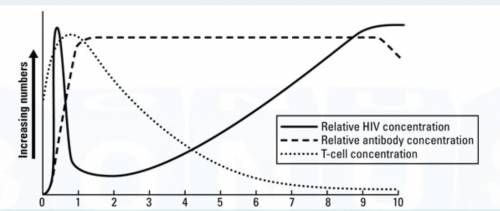
1. Using the graph, describe the events that occur in the body during the first year of
HIV infection.
2. Describe what happens between the first year and the tenth year of infection.
3. Explain why the concentration of antibodies begins to decrease after nine years of
infection.
4. At what point on the graph does an infected person have AIDS?
5. Why does the number of HIV particles begin to level off after nine years?
6. How do you think the high rates of HIV transmission in humans might be related to the length of time it takes for the virus to develop into AIDS?


Answers: 1


Another question on Biology

Biology, 22.06.2019 05:30
This class has taught you that the use of science and medicine in practical ways has become an international endeavor. one of the greatest examples of an international science accomplishment is which allows the profiling of human dna, useful not only to science but also medicine. a) forensic science b) the fbi c) the human genome project d) bioterrorism
Answers: 1

Biology, 22.06.2019 23:00
This problem has been solved! see the answerfor aerobic respiration, a variety of substances must be in a state of influx across the inner membrane. assuming a brain cell in which glucose is the sole energy source, indicate for each of the following substances whether you would expect a net flux across the membrane and if so, how many molecules will move in which direction per molecule of glucose catabolized.- electrons-pyruvate-oxygen-atp-adp-acetyl coa-glyceral-3-phosphate-nadh-fadh2-oxaloacetate-water-protons
Answers: 1

Biology, 23.06.2019 00:30
Many birth-control pills release a constant amount of synthetic estradiols and progesterone for 21 days, followed by 7 days when no hormones are ingested. which of the following statements most accurately describes the effects of birth-control pills? -birth-control pills maintain constant levels of estrogens and/or progesterone so there is no surge in lh and ovulation does not occur.-birth-control pills inhibit the development of the uterine lining so implantation of a fertilized oocyte cannot occur.-birth-control pills maintain constant levels of estrogens and/or progesterones and mask the release of the oocyte from the follicle.-the 7 days with no hormones does not allow a thick enough uterine lining to form so a fertilized oocyte cannot implant.
Answers: 2

Biology, 23.06.2019 01:10
Clownfish lay hundreds of eggs but only 10% to 15% survive into adulthood
Answers: 3
You know the right answer?
1. Using the graph, describe the events that occur in the body during the first year of
HIV infecti...
Questions


History, 30.03.2021 17:00

Geography, 30.03.2021 17:00

Chemistry, 30.03.2021 17:00




English, 30.03.2021 17:00

Mathematics, 30.03.2021 17:00

Mathematics, 30.03.2021 17:00


English, 30.03.2021 17:00

Mathematics, 30.03.2021 17:00




Mathematics, 30.03.2021 17:00


Physics, 30.03.2021 17:00

Mathematics, 30.03.2021 17:00




